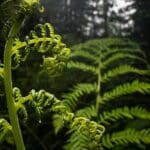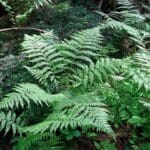Ladies fern / Spring / Summer / Autumn / Edible
Common Names
Lady fern, Female fern, female polypody
Botanical Name
Athyrium filix-femina
Scientific Classification
Kingdom – Plantae
Order –Polypodiales
Family – Athyriaceae
Physical Characteristics for Ladies fern
Ferns are different to the majority of plants we are familiar with, they are in a different category called pteridophytes as they don’t produce seeds but spores. They are very ancient plants, the first ferns grew on earth 300 million years ago!
Ladies fern is a medium to large hardy deciduous fern forming bushy rosettes of feathery ladder-like fronds. Growing to a max height of 1.2 but most commonly about 80 cm, they can be seen from March to November.
Leaves
Leaves are feathery lance shaped and twice to three times pinnate, yellowy- green in colour and emerging horizontally but drooping over at the tip. The fond tapers in gradually toward the tip. The segments have toothed margins. The midrib can be red or green. The Lady fern spreads out equally in height and width and is clump forming.
The underside of ferns have sori (spore bearing structures) on Lady fern they are curved J or C-shaped and this is a key characteristic.
Stem
Green or red with a groove.
No flowers, fruit or seed
Habitat
Native to the UK, wide spread and fairly frequent.
Preferring acidic and humid conditions but can tolerate a variety, found in woodland or shaded hedgerow with rich moist soils as the dampness aids with spore dispersal.
Known Hazards
Occasional reports of sickness but this is likely due to mis-identification or improper cooking.
Due to lack of information on safety during pregnancy and breast feeding, avoid during this time.
Only the young furled up fiddleheads are edible and absolutely must be cooked
There’s a lot of varying information on ferns being edible, reports of them being carcinogenic is referring mainly to bracken. Lady fern is not known to be carcinogenic but does contain an enzyme called thiaminase which can break down vitamin B1. However with cooking properly this is greatly reduced. Uncooked fiddleheads will make the vast majority of people quite sick.
Could be Confused with
Other ferns, including Buckler-ferns and Male-fern, which are difficult to tell apart.
Ferns can be a little difficult to separate from each other, since only a few species are edible this is definitely something to take your time with. You may need to spend a season observing them first in mature stages before collecting for food. A great way to learn is to buy a Lady fern from a garden centre where you can closely observe as it grows and be 100% sure of species, just be aware they may have been treated with chemicals.
Bracken is definitely one to avoid, it has carcinogenic properties and fortunately the young shoots look quite different, emerging as a trio of fronds and sori that run in a line along the leaf edge. ID guide link.
Dryopteris is a genus of fern of over 300 species with some that are quite similar to Lady fern. Dryopteris are known commonly as Wood ferns, Male ferns and Buckler ferns. Some of these species have fiddle necks that are totally covered in brown papery skin which Lady fern will never be and only has a few small pieces of the brown skin.
The Male fern- Dryopteris filix-mas TOXIC is one of the most common fern species in the UK especially if on limestone soil. Its important not to mix this one up as it’s considered very toxic to ingest.
Differentiating features -The Male fern has brown papery skin covering the fiddleneck that remains on the mature stem. Lady fern only has very little in patches on the emerged erect fiddleneck that is easily removed. On open fonds the Male fern has rounded sori ( spore producing structures on the underside of the leaf) and the Lady has J or C shaped sori.
Ostrich fern (Matteuccia struthiopteris) is similar but not a problem as it’s also edible as long as its cooked property. It’s less common being a naturalised garden escapee. It has a more prominent U shaped groove also both fertile and sterile leaves whereas Lady fern only has fertile. Ostrich fern also has very little brown papery skin on the fiddleneck.
Edible Uses
Edible with caution- Risk of mis-identification, they also must be cooked, eat occasionally.
A seasonal delicacy! Only the young furled up fiddleheads are edible and absolutely must be cooked, eating them raw will very likely cause sickness.
Firstly thoroughly clean the fiddle heads, and remove any brown papery skin, this is important as there can be organisms or trace toxins on them that can potentially cause illness.
However you decide to prepare the fiddleheads pre-cook them by boiling for 10-15 minutes first this ensures they wont be unevenly or under cooked, it removes bitterness bringing out their flavour and can also help them keep their fresh green colour. Sautéing is the most favoured way to finish them, but you can also roast or pickle them.
Just bear in mind they can go mushy and brown if over cooked.
They taste somewhere between asparagus and broccoli.
Check out our blog on edible ferns for deeper detail in preparation and cooking tips
Timing depends on climate but they typically start emerging from April. Only harvest those that are still furled up. You can use the whole stem as long as it’s still coiled up.
Only take a few from each fern so it can still grow new leaves for that season.
Notes on Herbal uses
High in vitamin A and C also antioxidants.
Extra notes from the Foragers
Lady fern is very hardy and can tolerate well below -20, it grows abundantly in Finland
Its common names “lady fern” and “female fern” are for its elegance and delicacy.
During the mid 1800’s the Victorians became obsessed with ferns, this craze was nicknamed Pteridomania, they were dug up in mass from the wild causing substantial ecological damage. Ferns became prominent in decorative design the fronds were used as stencils and even the famous custard cream biscuits if you look closely are decorated with ferns!
Two Chinese princes who were said to have famously survived exile in the wilderness for a long while on a diet of fern fiddleheads.
References
ps://foragerchef.com/how-to-identify-and-cook-fiddlehead-ferns/
https://en.wikipedia.org/wiki/Matteuccia
https://www.webmd.com/vitamins/ai/ingredientmono-492/ostrich-fern
https://itsavegworldafterall.com/sauteed-fiddleheads-with-garlic-lemon-butter/
https://dnr.alaska.gov/ag/akpmc/pdf/Fiddleheads.pdf
https://www.webmd.com/vitamins/ai/ingredientmono-720/male-fern
https://www.naturespot.org/species/male-fern











